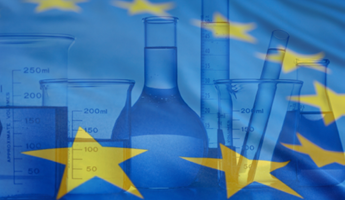Strategie voor duurzame chemische stoffen
-
Actuele wetenschappelijke onderwerpen
- Kankerpreventie
- Huidsensibiliserende chemische stoffen
- Perfluoralkyl bevattende chemische stoffen (PFAS)
- Microplastics
- Rubberkorrels en -strooisel op sport- en speelvelden
- Tatoeage-inkten en permanente make-up
- Glyfosaat
- Hormoonontregelende stoffen
- Bisfenolen
- Strategie voor duurzame chemische stoffen
- Dierproeven in het kader van REACH
- Ftalaten
- Biocides
- Lood
- Research to enhance protection of our health and environment
Strategie voor duurzame chemische stoffen

Op 14 oktober 2020 heeft de Europese Commissie haar duurzaamheidsstrategie voor chemische stoffen aangenomen. De strategie maakt deel uit van het streven van de EU om de vervuiling tot nul terug te brengen, een cruciale doelstelling van de Europese Green Deal. Met deze strategie wil de EU haar burgers en het milieu beter beschermen tegen schadelijke chemische stoffen en innovatie stimuleren door een veiliger en duurzamer gebruik van chemische stoffen te bevorderen.
De Europese Green Deal is de nieuwe groeistrategie van de EU die Europa zal transformeren tot een duurzame en koolstofneutrale economie, en vormt tegelijkertijd een antwoord op de economische crisis en de gevolgen van COVID-19.
Chemische stoffen zijn de bouwstenen van de producten die we gebruiken en van de hightechmaterialen die nodig zijn voor een circulaire en klimaatneutrale economie. De productie van chemische stoffen is ook een energie- en CO2-intensieve industriële sector. Door over te schakelen op chemische stoffen en productietechnologieën waarvoor minder energie nodig is, worden de emissies beperkt.
Als gespecialiseerd EU-agentschap draagt ECHA bij aan de strategie met zijn wetenschappelijke en regelgevingsdeskundigheid, databanken, digitale instrumenten en netwerken en praktische ervaring met de regelgeving inzake chemische stoffen, indien daarom wordt verzocht.
In het kader van de Europese Green Deal belooft ECHA als EU-organisatie en -werkgever zijn milieucertificering uit te breiden met het EU-milieubeheer- en milieuauditsysteem (EMAS) en tegen 2030 klimaatneutraal te zijn.
The Commission’s strategy provides an action plan to:
- Ban the most harmful chemicals in consumer products – allowing those chemicals only where their use is essential.
- Pay attention to the cocktail effect of chemicals when assessing chemical risks.
- Phase out per- and polyfluoroalkyl substances (PFAS) in the EU, unless their use is essential.
- Boost investment and innovative capacity for the production and use of chemicals that are safe and sustainable by design throughout their lifecycle.
- Promote the EU’s supply and sustainability of critical chemicals.
- Establish a simpler “one substance, one assessment” process for assessing the risks and hazards of chemicals.
- Play a leading role globally by championing and promoting high chemical safety standards and not exporting chemicals banned in the EU.
The Commission has asked ECHA to take an active role in the following work areas:
- Developing criteria for chemicals that are safe and sustainable by design.
- Assessing how to introduce mixture assessment factors in REACH.
- Establishing a “one substance, one assessment” process to coordinate hazard and risk assessment across chemicals legislation.
- Developing an indicator framework on chemicals as part of the Zero Pollution and 8th Environment Action Programme monitoring framework.
- Improving enforcement of chemicals legislation.
- Developing a strategic research and innovation agenda for chemicals.
- Developing EU-wide human and environmental biomonitoring in the context of the Partnership for the Assessment of Risk from Chemicals (PARC).
- Establishing an EU chemical early warning and action system.
In addition, ECHA will provide scientific and technical support for the impact assessment on planned revisions to REACH and CLP.
REACH revision
ECHA will support the amendment of REACH information requirements for substances that have critical hazard properties. The Agency is also involved in preparatory work for extending the registration duty to certain polymers, which currently do not need to be registered under REACH.
The Agency is a member in steering groups for studies and assessments on:
- information on volumes, uses, exposure/emissions and environmental footprint in REACH registrations;
- derived minimal effect levels (DMELs) for certain substances; and
- introducing a mixture assessment factor.
To improve the evaluation of chemicals, ECHA will provide information on the functioning of dossier and substance evaluation to the Commission with proposals to develop the two processes further.
To develop the use of the generic approach to risk management, ECHA will gather information on uses of certain hazardous substances. It will furthermore support the Commission in developing options to reform authorisation and restrictions. Additionally, the Agency will contribute to the development of criteria for essential uses of substances.
Until the generic approach to risk management is introduced and applicable in REACH, ECHA supports the development of criteria for prioritising substances and groups of substances for restrictions to establish a restrictions roadmap.
CLP revision
ECHA will assist the Commission in revising and developing new hazard criteria under the CLP Regulation for:
- persistent, mobile and toxic (PMT) and very persistent and very mobile substances (vPvM);
- terrestrial organisms;
- immunotoxicity and developmental neurotoxicity;
- endocrine disrupters; and
- persistent, bioaccumulative and toxic (PBT) and very persistent, very bioaccumulative substances (vPvB).
The Agency will assess the information it has available to identify substances that qualify for the new and further hazard classes or criteria and, where possible, set up a list of these substances.
European Commission
- Chemicals Strategy for Sustainability [PDF]
- Chemicals Strategy - background
- Chemicals Strategy implementation
- European Green Deal
- Commission's note to agencies on chemicals strategy 21 December 2020 [PDF]
- Commission's request to ECHA on chemicals strategy 12 April 2021 [PDF]
- Restrictions Roadmap
ECHA
- CLP Revision - ECHA input [PDF]
- ECHA's contributions to CSS work in 2023 [PDF]
- ECHA's contributions to CSS work in 2022 [PDF]
- ECHA's contributions to CSS work in 2021 [PDF]
- ECHA’s contribution to the Commission’s Restrictions Roadmap [PDF]
- ECHA news release 14 October 2020 - ECHA ready to help the EU achieve its ambitions for safe and sustainable chemicals


